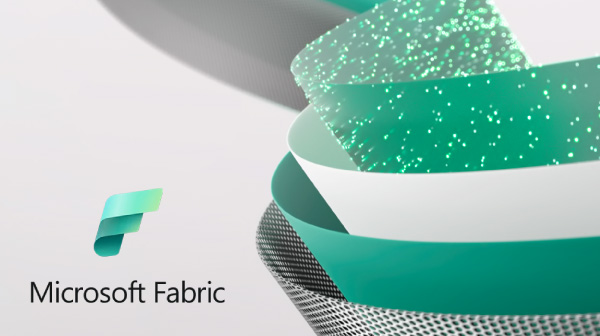FABRIC | 7 MIN READ
What Is Microsoft Fabric?
Learn more about Microsoft Fabric and its data analytics capabilities.

TABLE OF CONTENTS
Microsoft Fabric is a relatively new offering from Microsoft, but many of its features come from tried-and-true Microsoft tools. This guide covers everything you need to know about Microsoft Fabric, including what it does, how much it costs, and how it integrates with your existing software ecosystem.
Microsoft Fabric Explained
Microsoft Fabric is a data and analytics suite that brings together several business intelligence tools to create a unified data platform. Built on the base of Azure, Microsoft’s cloud computing tool, Fabric is a powerful resource for teams in search of ways to manage and analyze data.
Microsoft Fabric is designed for IT and data teams, including data engineers and business analysts, in need of the most advanced data tools available. Whether these teams need predictive analytics and demand forecasting or the ability to drill down into vast swaths of historic data, Microsoft Fabric offers a slew of capabilities.
Although Fabric debuted in 2023, its inclusive feature suite comprises multiple preexisting Microsoft tools and capabilities, including:
- Data Factory
- Data Engineering
- Data Warehouse
- Data Science
- Real-Time Intelligence
- Power BI
By combining the power of these individual modules, Microsoft Fabric creates an end-to-end environment where businesses can collect, sort, analyze, and distribute vital business data.

Features
As an integrated suite of data, productivity, and analytics solutions, Microsoft Fabric unifies multiple tools into a single environment. Think of Fabric as a house and its various modules as the rooms. Here are the features* Microsoft Fabric brings together:
- Data Factory – Manage pipelines as data synchronizes across multiple systems
- Data Engineering – Control how data is collected and managed across the organization
- Data Warehouse – Maintain a structured, centralized database where data can be sorted and viewed in bulk
- Data Science – Experiment with and model data to enable machine learning and build unique models
- Real-Time Intelligence – See data as it synchronizes across your tech ecosystem to get instantaneous, up-to-the-minute insights
- Power BI – Visualize business data with interactive models that can be shared across the entire organization
*Note that Microsoft Fabric only pulls select features from these tools; additional licensing is required to access the full functionality of each offering.
In addition to these six modules, two other solutions play a less direct role in Microsoft Fabric operations—OneLake and Azure. While OneLake and Azure are sometimes grouped together with Fabric, the three solutions serve different needs.
As part of the Microsoft ecosystem, the Power Platform is designed to seamlessly integrate with Microsoft’s other business solutions, such as the Dynamics 365 suite of software for customer relationship management (CRM) and enterprise resource planning (ERP).
Integrations
Microsoft Fabric connects with multiple solutions to gather raw business data and empowers teams to use that data however they want. Businesses that use Microsoft Fabric in tandem with other Microsoft solutions can enjoy some unique benefits.
Dynamics 365
Microsoft Fabric integrates seamlessly with Dynamics 365 solutions for sales, marketing, operations, and more to provide a unified platform for CRM and ERP data. The raw data that flows from Dynamics 365 into Fabric can be restructured and reorganized, then sent back into Dynamics 365 in an entirely new format (such as dashboards built with Power BI). This synchronization is powered by the connection between Dataverse, the database that operates under the hood of Dynamic 365, and OneLake.
Here are a few examples of what Microsoft Fabric users can do with integrations to specific Dynamics 365 Solutions:
- Dynamics 365 Sales – Export entities like leads, opportunities, accounts, and customer interactions into Fabric’s OneLake to easily compare with ERP and marketing data
- Dynamics 365 Customer Insights – Pull data from multiple campaigns and channels into Fabric to discover trends, top-performing content, and more
- Dynamics 365 Customer Service – Dive into customer service trends, such as what case types have the highest resolution costs and which agents or teams are most efficient
- Business Central – Access all historical transactional data to build reports, forecast future success, and predict what’s coming next
Microsoft 365 apps
Microsoft Fabric can also connect to the Microsoft 365 productivity suite to digest data, set workflow alerts, and embed powerful reports and dashboards. Here’s what Microsoft Fabric can do when paired with some of the most popular Microsoft 365 modules:
- Outlook – Embed reports and insights from Fabric into emails, and configure real-time intelligence workloads to send email notifications as needed
- Excel – Synchronize data between a live Excel spreadsheet and Microsoft Fabric to ensure OneLake receives as much timely data as possible
- Word – Embed live visuals from Fabric that automatically update as new data flows in
- Teams – Share reports and dashboards from Microsoft Fabric across individual chats and more populated channels to keep data accessible
- SharePoint – Synchronize SharePoint’s libraries and lists into Microsoft Fabric, then embed visual reports from Fabric onto SharePoint
Third-Party Applications
Although Microsoft Fabric is designed to integrate with other solutions from the Microsoft ecosystem, it can also be synchronized with third-party software, such as Salesforce CRM and Google Analytics. Some of these integrations are relatively easy to set up, while others require technical expertise to build and troubleshoot. It’s best to touch base with a dedicated Microsoft partner to integrate third-party applications with Fabric.
Third-party apps: https://slashdot.org/software/p/Microsoft-Fabric/integrations/
Pricing
Microsoft Fabric pricing is determined by two components: computing power (CUs) and OneLake data storage.
Capacity Units (CUs)
Firstly, users reserve Capacity Units, or CUs, to determine the computing power of Microsoft Fabric. A higher CU count correlates with faster performance for Fabric’s many workloads. CUs can be purchased in multiples of 2 based on SKU (stock keeping unit) tiers, with two payment plans available:
- Pay-As-You-Go (Monthly) – A monthly subscription that allows for flexibility as data needs change
- Reservation (Annual) – An annual subscription that gives teams a single pool of CUs at a 41% discount
| SKU Tier | F2 | F4 | F8 | F16 |
|---|---|---|---|---|
| CU Count | 2 | 4 | 8 | 16 |
| Cost (Annual) | $262.80 | $525.60 | $1,051.20 | $2,102.40 |
| Cost (Monthly) | $156.33 | $312.67 | $625.33 | $1,250.67 |
Implementations
Implementing Microsoft Fabric can take anywhere from a few weeks to several months. This range is influenced by the complexity of existing data and integrated software. Basic setups typically take two to three months, but more comprehensive implementations could run up to six months for mid-sized businesses or more for large enterprises.
Training and customization can prolong the overall implementation timeline for Microsoft Fabric. It’s best to contact a dedicated Microsoft solutions partner for more information and a reliable estimate.
Microsoft Fabric vs. OneLake, Azure, & Power BI
Understanding how Microsoft Fabric fits into Microsoft’s broader ecosystem can be confusing, since it overlaps with other solutions while also standing apart. Here’s how they differ:
Fabric vs. OneLake:
All of Fabric’s capabilities exist on OneLake, Microsoft’s data lake. Think of Fabric as the house and its features as the rooms—OneLake is the plot of land it sits on. As the storage foundation, OneLake provides the comprehensive data source that Fabric relies on.
Fabric vs. Azure:
Fabric is built on Azure’s cloud infrastructure, but the two tools serve different purposes. Azure is typically managed by IT teams for networking, security, and large-scale data management. Fabric, on the other hand, is designed for accessibility—making analytics and insights available to users across the business.
Fabric vs. Power BI:
Power BI is a component of Fabric, not a separate competitor. Fabric aggregates data from multiple systems, while Power BI visualizes that data in dashboards and reports. Some advanced Power BI features may require separate licensing, just as certain Fabric capabilities require their own subscription.

Why Businesses Are Turning to Microsoft Fabric
While Microsoft Fabric is still relatively new, early reviews highlight its ease of use, powerful capabilities, and diverse feature set. Related Microsoft solutions like Data Factory and Power BI—also offered as part of Fabric—already have strong reputations, with ratings consistently averaging more than 4 out of 5 stars on sites like G2 and Gartner.
Despite limited reviews, adoption has been rapid. Microsoft reports that more than 70% of Fortune 500 companies are among Fabric’s 21,000+ customers, spanning industries such as energy, professional services, consumer goods, financial services, and manufacturing.
But is it the right solution for your business? If you answer “yes” to one or more of the following questions, Fabric may be a smart fit:
- Are you a growing mid-sized or enterprise-level company?
- Do you struggle to gather, analyze, and share data across your business?
- Have you heavily invested in Microsoft solutions?
- Is data security a top concern at your company?
- Are other data management tools too code-heavy for your team?
- Is your business data spread across multiple disparate systems?
- Are your operations becoming increasingly data-driven?
Get Started with Fabric
If you’re interested in learning more about Microsoft Fabric and other Microsoft solutions—as well as how much they’ll cost and how they might fit into your existing tech stack—you can reach out to a Microsoft solutions partner like Cargas.
Cargas is one of the largest and most experienced Microsoft partners in Pennsylvania. For nearly three decades, we’ve helped organizations of all sizes and industry types implement Microsoft solutions. If you’re looking for a partner to assess your needs and help you understand what Microsoft has to offer, we’re here to help. Reach out to Cargas today!

Let’s Chat
Still have questions? Get in touch with our expert team of software professionals.